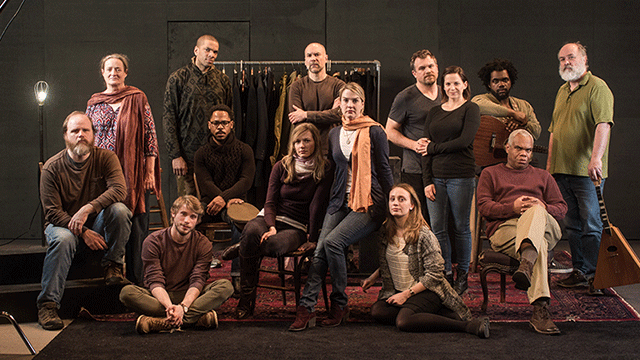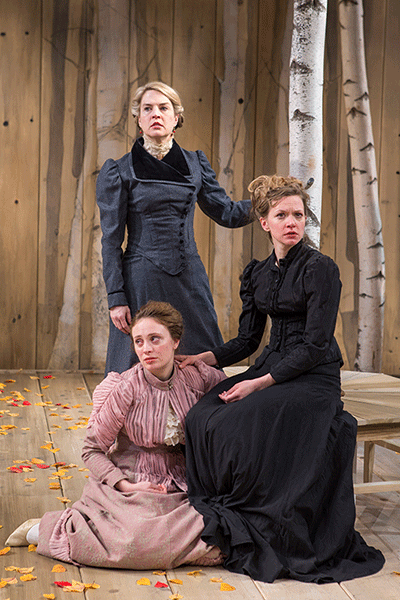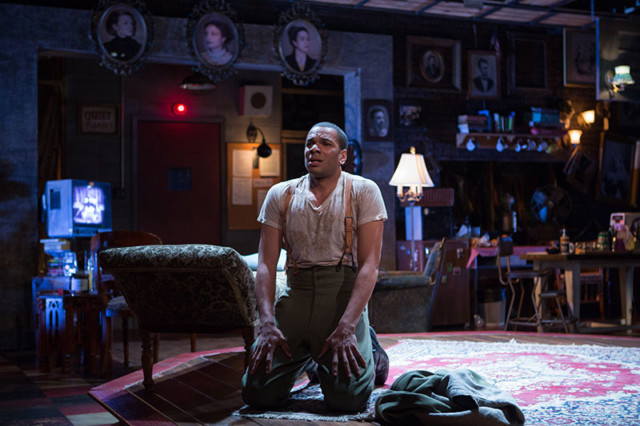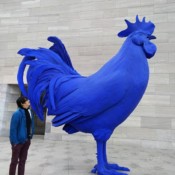Anton Chekhov may have been a physicist at heart. At least that’s the impression one may get after the latest — and excellent iteration — of “Three Sisters” now playing at Studio Theatre in Washington D.C.
The characters in the play — just like atoms — are in constant motion. Like the small particles that make up all forms of life and matter, they’re attracting each other when they’re a short distance apart, but once they meet and press together, they repel each other immediately. Much like most relationships in the real world, everyone seems to be falling in and out of love at the most inconvenient times.
Ahmad Coo is a producer and copy editor for the Global Business America show on CCTV America. His analysis represents his views alone.
The play covers four years in the lives of the sisters- and in the beginning of every act- the play picks up in the aftermath of some transformative events. It’s always tied to loss- whether it be the loss of a loved one, romantic love, freedom, money, even one’s home.
Everyone seems to be dissatisfied with their lives, with the three sisters Olga, Masha, and Irina Prozorov seemingly the most unhappy people living in town. Throughout the play we see them pining for past lives, or at least better prospects. All three are enamored with Moscow, the cosmopolitan city they grew up in. They blame their malaise and ennui on the backwater town they currently live in and make it a point to drill it into the conscious of their friends, family, and lovers.
But Irina, the youngest, is optimistic about the future because all three have plans to move back to Moscow, which they believe will be the panacea for all their life’s ills. That assumption, of course, is a beautiful fallacy. No one can run away from themselves, which is what the three sisters, in essence, are trying to do.
The oldest, Olga, is completely unhappy with her teaching job. She finds children exhausting and her choice of profession ill-suited to her personality. The middle child, Masha, is the angriest and probably the saddest among the three, and understandably so. She’s married to someone she considers her intellectual inferior.
Actually all of the characters who exist in the world of the “Three Sisters” are living the same crushingly boring lives, more or less. But unlike Prozorovs, they know they can’t escape their circumstances and have also more or less accepted their lot in life. That includes the soldiers from an army regiment stationed near their home.

The cast of Three Sisters. Back: Nancy Robinette, Biko Eisen-Martin, Greg Stuhr, Josh Thomas. Middle: Todd Scofield, Ro Boddie, Caroline Hewitt, Bridget Flanery, Ryan Rilette, Kimberly Gilbert, Craig Wallace, Nick Torres. Floor: William Vaughn, Emilie Krause. Photo: Teddy Wolff.
Chekhov’s set-up for the three sisters’ world is perfect for his obsession with the dissection of the human condition. Just like his other plays, “Three Sisters” lacks a plot in the classic sense. There is a definite passing of time, but there is no climax or denouement. There’s also no clear-cut hero, heroine, or villain. What you have instead is ‘theatrical realism’ — a play that tries to replicate real life. Unlike most of his peers at the turn of the century, his characters struggle with a monotone life, mostly devoid of meaning or significance. What he plays off of is their struggle to live more vital lives.

Bridget Flanery, Emilie Krause, and Caroline Hewitt in Three Sisters. Photo: Teresa Wood.
But they never really succeed in realizing some sort of significance. Instead they have inner turmoil and the push and pull of their baser desires: lust, rage, greed, etc. This is Chekhov’s wheelhouse. But his dissection of the characters’ lives isn’t rooted in malice. He’s prodding and exploring, trying to get at what makes everyone tick and understand why and how they make certain decisions, sometimes to their own detriment. Instead of your usual plot devices, their inner turmoil is what drives the play forward. There’s almost a voyeuristic joy that’s present for the audience because all the characters’ neuroses are brought to the surface. But I have to say here that the play isn’t rendered a heavy melodrama with all this examination.
Since Chekhov doesn’t rely on one character to be the center of the production, he fleshes out almost all of the play’s characters. That’s what sets him apart from most playwrights I’ve read or seen. There are no obvious protagonists or villains — highlighting the fact that there’s always a grey area when it comes to human behavior. I must applaud Studio Theatre for this version of “Three Sisters” because, for them, human behaviors transcend race. That’s why it’s so refreshing that the producers and directors decided to go with a multi-ethnic cast to reflect that.
Chekhov had always intended the play to be tragicomedy. But the production’s humor comes from the desperate situations they find themselves in, as well as a smattering of schadenfreude. For instance, one of the sisters becomes the object of affection for almost all the male leads. Unfortunately for the love-struck fools, she doesn’t feel anything for anyone, thus dooming these ill-fated attempts at romance.
The “Three Sisters” characters careen from one personal disaster to another and the audience is treated to the absurdity of the situations they find themselves in. At times the humor gets so dark, especially when find out that everyone in the play is in love with somebody else.
In the end, we find the sisters’ world radically transformed because of this love, seemingly for the worse. In this sense, Chekhov can almost seem cruel to his characters. But human beings are exceptionally gifted in making themselves miserable via the wrong choices and the most disastrous of life partners. When we remember how much of human misery is self-inflicted, Chekhov isn’t being mean. He’s merely stating universal truths. While humans may know what or who makes them truly happy, they refuse to accept it and believe there’s something or someone better out there.
And this is how we find Olga, Masha, and Irina at the end of the play. They’re all caught in their own thoughts about what and who could have been. Soon we hear the dissonant sounds of violas once more, the notes and jarring compositions bouncing around in our ears and heads. It reminds us again how the play’s characters, like atoms, attract and repel each other, heading for other still unknown destinations and futures.
No Script? “No Sisters”? No problem: another review
“No Sisters” is a whirlwind of activity. Characters are coming in and out of what looks like a back room/greenroom where they engage the crowd in dialogue about the play, politics, and pretty much anything under the sun, including the play they’re in, Chekhov’s “Three Sisters”.
Posner’s “No Sisters” is the irreverent companion piece to Chekhov’s “Three Sisters” – which are both playing at Washington D.C.’s Studio Theatre. If you don’t already know, they’re being staged in the same two hours simultaneously — with some characters in both productions racing from one set to the other.
It sounds a bit chaotic but the playwright Aaron Posner has written the play in such a way so as not to interrupt the flow of Chekhov’s masterpiece. Just to be clear, you have to watch “Three Sisters” first before you sit down to witness the glorious mess that is “No Sisters” to get a fuller grasp of Posner’s project.
In Posner’s script, the so-called third wall between the cast and the audience has vanished into thin air. While the actors follow a script, I think they’ve been given license to address the audience directly and improvise. The result is nothing short of entertaining. More importantly though, it helps the audience get to further know and understand some of the more interesting characters on the periphery of the “Three Sisters” — namely Solyanov; Masha’s husband, Kulygin; Andrey Prozorov; and his wife Natasha.

Biko Eisen-Martin in No Sisters. Photo: Teresa Wood.
Solyony is a whirlwind of a character. The actor who plays him is an imposing human being, tall with a booming voice. In t”Three Sisters” he’s the chaos agent, seemingly insane and out of control with his emotions. His motivations are unclear, until he comes out and professes his love for one of the sisters. But even in the throes of romance, there’s an emotional violence about him that’s unsettling.
Thanks to “No Sisters”, we find out that there’s a cause for Solyony’s darkness. It softens that focus a little to reveal a more human character that was completely lacking in “Three Sisters”. Loneliness can make monsters out of men, while it makes mice of others. That’s especially true of Kulygin.
In the main show, Kulygin is a cuckold worthy of everyone’s scorn. Thanks to Posner’s exposition on his character in “No Sister” however, he’s one of the most loving and gentle characters to ever grace the stage. The brother of the three sisters’ Andrey and his wife are also characters steeped in loneliness. Despite being married, they’re so isolated from one another that they might as well be living in separate worlds.
All the minor characters are also going through some sort of existential crisis as they interact with the audience — with Solyony even directly asking some members of the audience about what makes them happy. They’re all trying to make sense of their world in the “Three Sisters”. But while some of them think they have found answers to their most pressing problems in “No Sisters”, we realize they’re just as confused about life as before the play started, if not even more.
Besides the absence of the third wall, another feature that sets “No Sisters” apart from its Chekhovian predecessor is the use of modern English — thus giving a very modern spin on the characters’ views of the world of the three sisters. It also informs the audience that the problems and neuroses that the Prozorovs and the people in their lives wrestled with a few hundred years ago are the same miseries that afflict us today.
 CGTN America
CGTN America
 The Prozorov sisters of Three Sisters. Bridget Flanery, Caroline Hewitt, Emilie Krause. Photo: Teddy Wolff.
The Prozorov sisters of Three Sisters. Bridget Flanery, Caroline Hewitt, Emilie Krause. Photo: Teddy Wolff.

